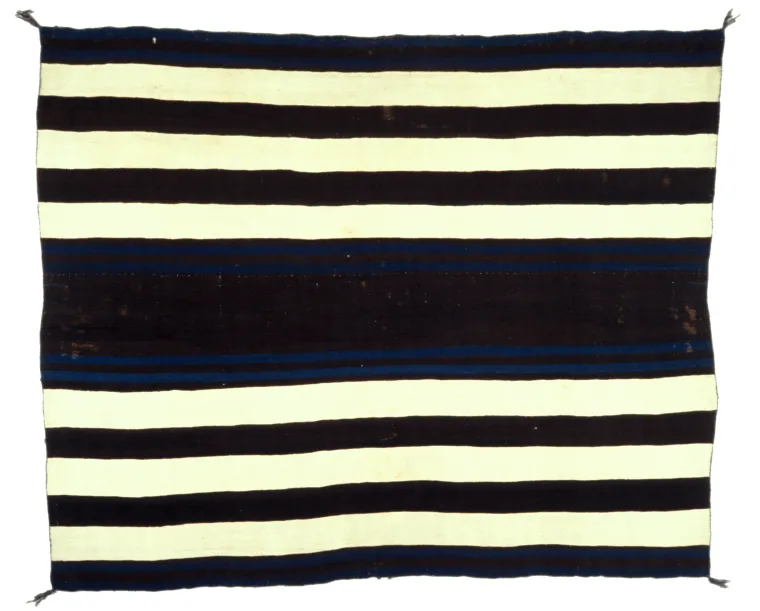
Chief’s-style blankets have two broad zones of black and white bands, separated by narrower blue, black, and sometimes red bands. Several design phases have been identified. The first phase began around 1800 and has simple groups of broad bands. The second phase, with small rectangles appearing across the three widest bands, developed by 1850. In the third phase, introduced in the 1860s, triangles and diamonds appear on top of the background bands. A fourth phase with even more prominent foreground elements evolved after the 1870s.
The use of “chief” by scholars and collectors to describe this blanket style indicates the high quality of these blankets and associates them with the North American Plains Indians who avidly acquired them through trade. Unlike the more egalitarian Navajo tribe governed by localized headmen, Plains Indian tribes had centralized leadership with chiefs. This style name may have derived from the idea that chiefs wore them. Navajos call this blanket style hanoolchaadi, which refers to carding, the process of preparing wool before spinning.
Above:
Chief's-style blanket first phase
ca. 1800-1850
Weft-faced plain weave
1.91 x 1.61 m; Tassels 0.080 m
63.386 x 75.197 in.; Tassels 3.150 in
Catalog No. E-1200
Gift of Mary Cabot Wheelwright, 1942
“First phase blankets are the earliest and rarest version of the Navajo chief’s style. The smooth, shiny wool is handspun from the Churro sheep, a breed first introduced by the Spanish in 1598. Blue indigo dye from Mexico was used with natural white and brown-black wools.” —Ann Hedlund
“The Navajos don’t have chiefs, but other tribes do. Plains Indians were considered rich if the chief wore a Diné blanket. That’s why these are called chief’s blankets.” —Barbara Ornelas
“I see a rebelliousness to this—avoiding the usual color contrasts. People claim that we wove for purely economic reasons, but if that were true, then weavers would have cranked blankets out instead of making these aesthetic choices—by placing the black next to blue, a choice is implied. They wanted to make art and they did care about what they were making. Knowing this makes the objects seem much more human to me.” —Sierra Ornelas
“Weaving a first phase is much harder than weaving a second or third, because you have to make the lines really even. It’s real hard to do, because some of the wool is finer, some heavier.” —Barbara Ornelas
“Also, these are the hardest things to weave because it is difficult to control your sides. Your sides will pull in. The pattern keeps the fabric solid, so it’s harder for the sides to go in. If you do stripes, you have to pay close attention to how you weave.” — Michael Ornelas
“I bet that’s why there are a lot of ‘lazy lines’ (diagonal joins across solid colors) back then, to keep the sides straight, like expansion joints in a bridge.” —Sierra Ornelas
| Function | Fiber | Type | Ply-Spin-Twist | Color | Dye | Count * | ||
|---|---|---|---|---|---|---|---|---|
| Warp | Wool | Handspun | -- | Z | -- | White | None | 11 |
| Weft | Wool | Handspun | -- | Z | -- | White | None | 71 |
| Weft | Wool | Handspun | -- | Z | -- | Med Blue | Indigo | 71 |
| Weft | Wool | Handspun | -- | Z | -- | White | None | 71 |
| Weft | Wool | Handspun | -- | Z | -- | Dk Brown | None | 71 |
| Ecord | Wool | Commercial | 2(4 | z | S)Z | Med-Lt Blue | Indigo? | 2 |
| * threads/inch | ||||||||
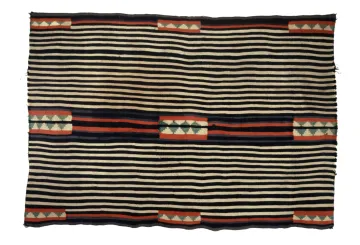
Woman's-style blanket, second phase
ca. 1895-1900
Tapestry weave, interlocked joins
1.475 x 1.03 m
40.551 x 58.071 in
Catalog No. E-1643
Gift of K. and A. McEwen, 1943; purchased by donors from Babbitt Brothers
“The design of the so-called woman’s-style blanket is similar to the chief’s style, but smaller, with narrower bands and muted colors. Few photos show women wearing these blankets, so the name used by writers and collectors indicates a style rather than the owner’s gender.” —Ann Hedlund
“I want to give people an idea that we didn’t go straight from first to second phase, and second straight to the third. There was more variation in styles than that.” —Barbara Ornelas
“Yes, it wasn’t a master evil plan! I like this one—the others are more traditional, in a ‘traditional’ sense.” —Michael Ornelas (smirking at double meaning)
“This gives a different take from a traditional second phase chief’s blanket. It shows that weavers back then were doing different kinds of things, not just one certain thing. The stripes and the colors and patterns—the tree-like ones, they’re just different.” —Barbara Ornelas
| Function | Fiber | Type | Ply-Spin-Twist | Color | Dye | Count * | ||
|---|---|---|---|---|---|---|---|---|
| Warp | Wool | Germantown | 4 | z | S | White | None | 8 |
| Weft | Wool | Germantown | 4 | z | S | Dk Blue | Synthetic | 51 |
| Weft | Wool | Germantown | 4 | z | S | Purple | Synthetic | 51 |
| Weft | Wool | Germantown | 4 | z | S | Black | Synthetic | 51 |
| Weft | Wool | Germantown | 4 | z | S | Red | Synthetic | 51 |
| Weft | Wool | Germantown | 4 | z | S | Green | Synthetic | 51 |
| Weft | Wool | Germantown | 4 | z | S | White | None | 51 |
| Weft | Wool | Germantown | 4 | z | S | Gray | None | 51 |
| Ecord | Wool | Germantown | 3(4 | z | S)Z | Black | Synthetic | 2 |
| * threads/inch | ||||||||
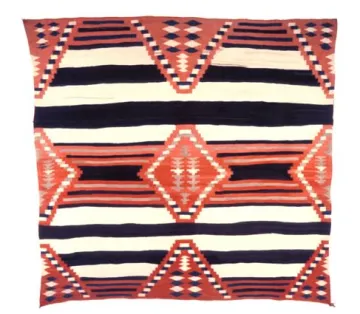
Chief's-style blanket, third phase
ca. 1880-1890
Tapestry weave, interlocked joins
1.73 x 1.65 m; Tassels 0.050 m
64.961 x 68.11 in.; Tassels 1.969 in
Catalog No. 8400
ASM purchase from Nelle A. Dermont, 1919
“When wrapped around the wearer, the side triangles on blankets like this met in front, appearing as whole diamonds. The wearer could fold the top edge down as a collar, so the patterns overlapped each other.” —Ann Hedlund
“Diagonal lines evident in the solid colored areas—so-called ‘lazy lines’—allowed weavers to work in sections without creating a vertical slit.” —Ann Hedlund
“Today, in my family, we never do lazy lines. We use stepped designs and don’t need them. In one big rug, we worked in sections—my sister would work on one side, I worked on the other, and we left the middle part open. Later I sat in the middle and wove that part, using a needle on each side to join the steps together.” — Barbara Ornelas
“Maybe they’re not really lazy lines.” — Michael Ornelas
“Yeah, they’re sort of smart lines.” —Sierra Ornelas (laughing)
“My grandmother was so upset by that name. We don’t know where that term came from.” —Barbara Ornelas
| Function | Fiber | Type | Ply-Spin-Twist | Color | Dye | Count * | ||
|---|---|---|---|---|---|---|---|---|
| Warp | Cotton | String | 4 | z | S | White | None | 6 |
| Weft | Wool | Handspun | -- | Z | -- | White | None | 46 |
| Weft | Wool | Handspun | -- | Z | -- | Dk Brown | None | 46 |
| Weft | Wool | Handspun | -- | Z | -- | Med Blue | Indigo? | 51 |
| Weft | Wool | Handspun | -- | Z | -- | Lt Green | Native? | 51 |
| Weft | Wool | Handspun | -- | Z | -- | Red | Synthetic | 56 |
| Ecord | Wool | Handspun | 2 | z | S | Red | Synthetic | 2 |
| * threads/inch | ||||||||
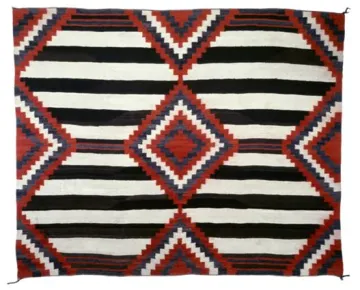
Chief's-style blanket/rug, third phase
ca. 1890-1900
Tapestry weave, dovetailed joins
1.725 x 1.43 m; Tassels 0.070 m
56.299 x 67.913 in.; Tassels 2.756 in
Catalog No. E-1600
Gift of Margaret Link Schevill, 1942
“This is something that I would do. That is, I identify with the weaver. Her style is really uniform.” —Barbara Ornelas
“This heavy textile was woven as a rug rather than a wearing blanket. The same pattern is pictured in a 1905 mail-order catalogue from Hubbell Trading Post in Ganado, Arizona. It is listed as the ‘very oldest pattern known’ and then cost about $25.” —Ann Hedlund
“I don’t feel invited by this rug. It’s sort of like a glamorous woman saying, ‘Don’t touch me.’ It has a cool, aloof attitude, like Katherine Hepburn or Greta Garbo—aloof. Too cool for school! It’s a bit high strung, but I dig it.” —Sierra Ornelas
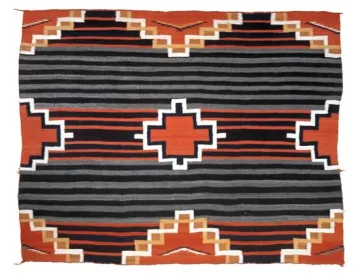
Woman’s-style blanket, third phase
ca. 1885-1900
Tapestry weave, dovetailed and diagonal joins
1.5 x 1.175 m
46.26 x 59.055 in
Catalog No. E-3270
Gift of Elizabeth Crozer Campbell, 1956; collected by donor’s father
“‘Traditional’ is having big bands all the way across—the wider black and white kind—with patterns at the bottom, middle and top. This one has so many tiny stripes across, even though it has the patterns on the bottom, the middle and the top. The color combinations make it darker than other chief’s blankets.” —Barbara Ornelas
“Such patterning shows influences of trader J. L. Hubbell who encouraged weavers in the Ganado area to repeat earlier wearing blanket styles in heavier rugs for the floor.” —Ann Hedlund
“To get good shades of gray, you have to dye your black first and get the wool as dark as you can. Then you sort your black wool and white wool and you card them together. You have to card two to three times to get the colors that you need, otherwise you will have streaks.” —Barbara Ornelas
| Function | Fiber | Type | Ply-Spin-Twist | Color | Dye | Count * | ||
|---|---|---|---|---|---|---|---|---|
| Warp | Wool | Handspun | -- | Z | -- | White | None | 6 |
| Weft | Wool | Handspun | -- | Z | -- | Red | Synthetic | 30 |
| Weft | Wool | Handspun | -- | Z | -- | Yellow | Synthetic | 30 |
| Weft | Wool | Handspun | -- | Z | -- | Orange | Synthetic | 30 |
| Weft | Wool | Handspun | -- | Z | -- | White | None | 30 |
| Weft | Wool | Handspun | -- | Z | -- | Black | None Blk+Native | 35 |
| Weft | Wool | Handspun | -- | Z | -- | Gray | None-Blend | 35 |
| Weft | Wool | Handspun | -- | Z | -- | Dk Blue | Indigo | 40 |
| Ecord | Wool | Handspun | 3 | z | S | Magenta | Synthetic | 2 |
| * threads/inch | ||||||||





